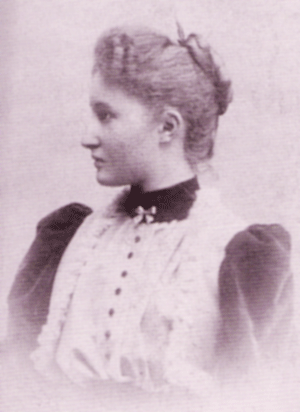Flora Langerman Spiegelberg
Flora Langerman Spiegelberg transformed two cities, championing education in Santa Fe and public sanitation in New York. Spiegelberg moved with her husband to Santa Fe in 1875, where he became mayor and probate judge. There, Spiegelberg created playgrounds and children’s gardens and founded several schools. In 1889, the family moved to New York, where Spiegelberg helped found the Committee for Jewish Women and the Temple Emanu-El Sisterhood. In 1910, she began her campaign to improve New York’s garbage collection with presentations that included a film Thomas Edison made for her. She argued for sanitation regulations as well as better wages and working conditions for garbage collectors. She was appointed to the New York City Health Commission, the Street Cleaning Department, and the Public Market Commission.
Flora Langerman Spiegelberg’s life did not fall neatly into typical historical categories. Born on September 10, 1857, her eighty-seven years spanned nearly half of two centuries. A native of America yet educated in Europe, Spiegelberg was a nineteenth-century settler of New Mexico and a twentieth-century progressive reformer in New York City. However, Spiegelberg did not feel that her work as a pacifist, a writer, and a founder of both nonsectarian public schools and Jewish women’s organizations crossed gender boundaries. In reference to her intensive efforts to improve New York City sanitation, she remarked, “It is a womanly hobby. Unusual, if you like, but quite in the province of a woman.”
Early Life
Flora Langerman Spiegelberg was the daughter of Jewish New York City residents William Langerman of Bavaria and American-born Rosalia Lichtenheim. Her maternal grandfather had come from Hamburg to New York in 1820 and married a Christian descendant of a Hessian officer who had fought with the colonists in the Revolutionary War. Two months after Flora’s birth, the family moved from New York City to San Francisco, spurred by her father’s interest in the California gold rush. The Langermans returned to New York in 1866, a twenty-one-day journey via the Panama Canal. When William Langerman died three years later, Flora’s mother took her to Nuremberg, Germany, to complete her education.
Marriage and Life in Santa Fe
Thirty-year-old Willi Spiegelberg, one of the prosperous merchant and banking Spiegelberg brothers of Santa Fe, traveled to his German homeland in 1874. He knew of the Langermans through distant family connections. Flora succinctly related the outcome of his visit: “I was young and he was handsome and in a very short time I became Mrs. Willi Spiegelberg.” Their wedding was the first in Nuremberg’s new Reform temple. In 1875, after an extensive European honeymoon, the couple arrived in New York and headed for New Mexico. The journey culminated in the arduous Santa Fe Trail. Spiegelberg later recalled her shocked reaction to one night’s accommodations where she slept among numerous cowboys, separated from them by only a muslin curtain.
Once settled in Santa Fe, Spiegelberg assumed a leading social position among the area’s prominent families. She frequently entertained visiting dignitaries such as Generals Grant and Sherman, President Hayes, and local officials such as the governor and archbishop. Her appreciation for diverse cultures coexisted with her strong Jewish identity. Few in number, Jewish New Mexicans had strong social and commercial ties to both Catholic and Indian communities. These relationships led to Willi Spiegelberg’s election as mayor in 1880 and probate judge in 1884.
Activism in New York
In 1889, the Spiegelbergs and their two daughters (Betty and Rose) left Santa Fe for New York, the last members of the Spiegelberg family to relocate. They were concerned about their children’s education and marriage possibilities within the faith. In New York, Spiegelberg soon became a founding member of the Committee for Jewish Women, the Temple Emanu-El Sisterhood, and the Friendly Club (the first Jewish working girls club). Around 1910, she began a decades-long campaign to improve New York City garbage collection and disposal. Lectures included A Menace to Public Health, a film Thomas Edison made for her in 1914. Nicknamed “Garbage Can Flora,” she won the praise of sanitation workers by supporting their demands for better wages and working conditions, and received successive appointments to the New York City Health Commission, the Street Cleaning Department, the Bill Board and Daylight Saving Commissions, and the Public Market Commission. Spiegelberg also promoted and gave vocational instruction, advocated her “Ten Commandments for World Peace” (1919), which called for a constitutional amendment to ensure that war could be declared only by popular vote, and published numerous children’s stories.
Flora Langerman Spiegelberg died on December 8, 1943, in New York, having made substantial innovative contributions to civic welfare and Jewish life.
Selected Works
Princess Goldenhair and the Wonderful Flower (1917, 1932, 1939).
“Reminiscences of a Jewish Bride of the Santa Fe Trail.” Part 1. New York Jewish Spectator (August 1937): 21, Part 2. New York Jewish Spectator (September 1937): 44.
“Reminiscences of Governor Lew Wallace.” Oklahoma City Jewish Chronicle (February 1934): 6.
“Tribute to Archbishop Lamy.” Oklahoma City Jewish Chronicle (December 1933): 3.
AJHQ 55 (1965):98–106, 56 (1968):371–451.
BEOAJ; Lawson, Michael L. “Flora Langerman Spiegelberg: Grand Lady of Santa Fe.” Western State Jewish Historical Quarterly 8 (July 1976): 291–308.
Obituary. NYTimes, December 9, 1943, 27:1.
Spiegelberg, Flora Langerman. Manuscript catalog and papers. AJA, Cincinnati, Ohio, and Microfilm No. 511. Hebrew Union College Library, Los Angeles Calif., and papers. University of New Mexico Library, Albuquerque, N. Mex..
Tobias, Henry J. A History of the Jews in New Mexico (1990).
UJE.
WWIAJ (1938).





